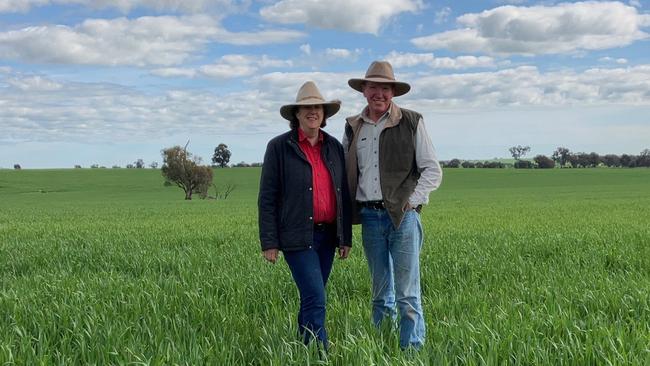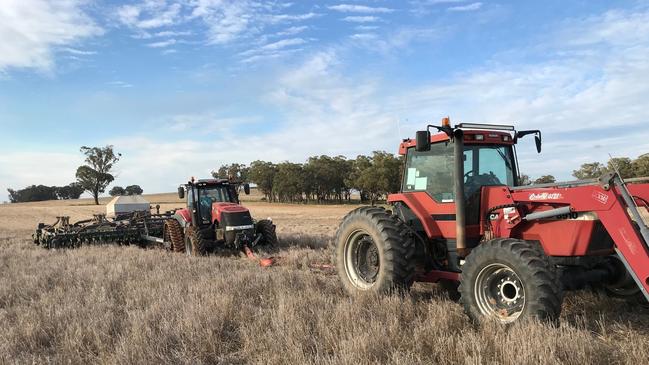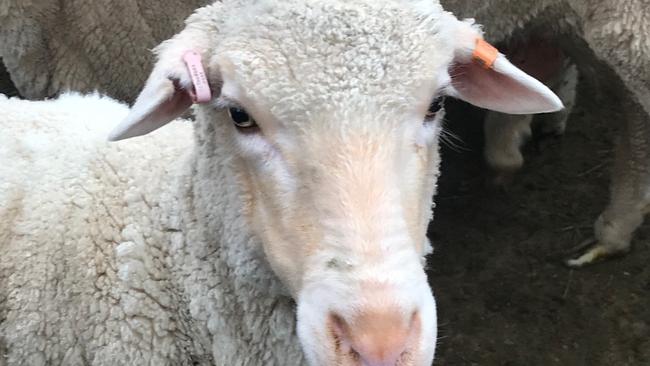‘I was burnt out’: How David and Jenny Thompson learned to love farming again
David and Jenny Thompson’s journey back to enjoying their vocation came from a decision to shift focus away from time-consuming practices.
After 30 years driving a sprayer on his family cropping property, David Thompson realised he was burnt out.
His journey back to loving farming came from a shift to mixed farming, and a decision to focus on building healthy soils and plants rather than fighting pests.
“For me it was important to get away from spraying,” David said.
When David and his wife Jenny set up their own property in 2010 as part of a family succession plan, the couple decided to look for ways to run the property without a time-intensive spray program.
At first they were drawn to research showing the importance of maintaining stubble for retaining moisture in the soil – a bonus in an area prone to drought.
From there, they found ways to time their rotations differently and use sheep in innovative ways to reduce their reliance on insecticides and fungicides, while maintaining ground cover and building soil health.
They insist they are “not idealistic” and they will use sprays when they need to, but their journey has shown it is possible to produce high-yielding crops with fewer inputs.
David and Jenny farm 2230ha at Illabo in NSW, of which 1200ha is cropping.
They run 2400 Merino ewes producing wool and first-cross lambs sold at weaning.

HEALTHY SOILS
At the centre of David and Jenny’s philosophy is a desire to build healthy soils.
When David checks the progress of a crop, one of the first things he does is dig down into the straw with his hand to check the soil.
“To a conventional farmer, the paddocks might look untidy. There’s lots of straw,” he said.
“Our farming is all about good gardening, we want straw for mulch, we want moisture retention and we want weed suppression.
“You’ve got three years of background straw. You’ve got barley straw, wheat straw, and the dry canola straw (from three years of crop rotations).
“And then when you start to peel the straw away, you then start to see lots of fine root hairs on your crop. It seems to be when we’ve got high residue systems, you end up with a lot of fine root hairs kind of break down in the soil.
“As you peel back the layers, you can see fungi starting to break down some of the straw, improving the soil and getting better infiltration. And then when you go below the straw you’re starting to get lots of worm castings.”
In the decade since David and Jenny bought their Bethungra Park property, they have seen their strip and disc, controlled traffic and soil health-focused farming methods gradually transform the property’s soil.
In 2019, when they bought some new paddocks and planted them for the first time, they were able to see a stark difference between the soil they had been building through their techniques and soil that had been conventionally farmed.
The new paddock they had bought was “totally bare, no ground cover, characterised by full dams, poor infiltration, raised dust and rock hard”, David said.
An agronomist who surveyed the paddock told them bluntly “you’ve got no topsoil”.
David decided to plant one of the new paddocks with Latrobe barley, which had a shorter moisture requirement than Planet barley.
He then planted a comparison paddock – one with years of retained stubble – with Planet barley, and gave it the same inputs, the same fertiliser and the same chemicals through the season.
While the Latrobe barley paddock struggled in the dry 2019 season, the Planet barley paddock had enough moisture retained in the soil to do OK.
In the end David harvested 1.7 tonnes a hectare from the Latrobe barley paddock and 3.7 tonnes a hectare from the Planet barley.
“It was such a strong difference for moisture retention,” he said.
As well as higher yields in dry years compared to surrounding properties, David said the quality of his crops were often higher than those grown on drier blocks.
“(In dry years) all the farms around us were having low falling numbers problems, our falling numbers were fine this year. It’s often the same with screenings.
“They have low test weight canolas, we have high test weight canolas.
“We’re just in a different farming system with different outcomes,” he said.
But while the system at Bethungra Park thrived in dry years, in wet seasons like this year the story was a little different, David said.
This year about 15 per cent of his crop was a write off – five per cent because he was unable to get onto wet paddocks at sowing time, and because another 10 per cent had either drowned or been eaten out by slugs, slaters and rabbits.
In comparison, his neighbour’s canola was looking “fantastic”.
“He was making dust when he was sowing. The soil’s really hard but in a wet year like this there is enough moisture and his crop is brilliant.
“He wouldn’t want our farming system at all. But it evens out in the end,” he said.

’FLEXIBLE’ APPROACH TO FUNGICIDES AND INSECTICIDES
In an effort to build healthier soils, David and Jenny have been cutting down on their use of fungicides and insecticides.
“If it comes down to it and we have to spray we will,” David said.
“The idea is we want to reduce our fungicides because we want we want mycorrhizal fungi in the soil.
“The top 10 centimetres of the soil is for all your critter and your bugs and things and where there is oxygen, but to go below that and get soil improvement you need mycorrhizal fungi. “So if we can reduce our fungicides, (that helps),” he said.
The first strategy for managing stripe rust without fungicide was to send the sheep in to an infected paddock, David said.
With a crop like Bennett wheat, which was very susceptible to rust, David sends sheep into an infected paddock in early August to eat all the leaves off the wheat, which gets rid of the rust, he said.
Another strategy to cut down on summer spraying was to plant and harvest crops earlier.
“We’re cutting our chemical usage a bit by having a growing crop earlier in the year if we’ve got the moisture with the system,” David said.
But some crops, like canola, were very difficult to grow without insecticides.
“We find to get canola in our system we need to use insecticides to get canola establishment and pasture establishment,” he said.
Canola planted into heavy straw in wet conditions like this year came under a lot of early pressure from pests.
“Our strategy this year was put in more winter grazing canola, which flower later and generally don’t need don’t need the fungicide applied. Because it’s warmer and drier when they start flower,” he said.
A strategy he used to reduce the need for insecticides was to build up the health and resilience of plants using foliar nutritional sprays.
Using foliar nutritionals, he has found the farm still had aphids, but “they don’t get to the economic threshold of needing the spray”.
The nutrients also help the plants to better withstand temperature extremes. A healthy plant with the right balance of sugars “can handle a bit of cold stress, a bit of frost stress,” he said.
“They’re complicated mixes, and it adds a bit of complexity, but I’d rather be out spraying foliar nutritionals than spraying herbicides,” David said.
The results so far have been promising. Last year the farm averaged 5.2 tonnes a hectare for wheat, 4.7 tonnes a hectare for barley and two tonnes a hectare for canola, despite some waterlogged paddocks.

ALL ABOUT GROUNDCOVER
To retain soil moisture and build healthy soils, the Bethungra Park operation maintains ground cover year round.
Sheep are central to that effort.
The farm runs 1030ha of “frosty, wet or rocky” pasture for sheep.
They grow long-term perennial pastures, and mixture of lucernes, clovers and perennial grasses.
Sheep graze through the Bennett wheat crops through to about mid August.
After the sheep are taken off, the crop is allowed to recover and companion plants are sprayed out.
One challenge with maintaining ground cover was knowing when the time was right to move sheep off a paddock, David said.
A barley feeder has been the key to knowing when it was time to move a flock.
After trialling sheep on a feeder a few years ago, David found it improved productivity and he hasn’t looked back.
“What we found is when we divide the mob in half put half on barley feeders on unlimited pasture, and half on unlimited pasture without barley, we got half a kilo more wool off the ewes, the lambs were five kilos heavier at sale time. And we had a higher lambing percentage, which was probably more about lamb survival, because the mother had more milk and more energy,” he said.
He said sheep tended not to need much barley when they had plenty of stubble to eat, and keeping an eye on when they began to spend more time around the feeder was a good indicator of when it was time to move them off a paddock.
Multispecies pasture crop have also made a big difference to productivity.
“We’ve set our rotations and cropping up so that every sheep has a dual purpose canola multispecies June into July, and then July and August they get the all purpose multi species wheat. And we just see the condition start to stack on the lambs and stack on the ewes.
With improvements to infrastructure on the farm over time, the couple hope to gradually increase sheep numbers to 3000 Merino ewes.





